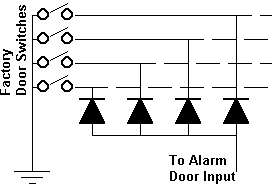Diodes are electronic devices that let current pass only in one direction. It is used for many applications, among them to isolate circuits. Diodes can be obtained at any electronics store (i.e. Radio shack), cost very little and come in different current ratings.
When installing alarms, in some occasions, diodes become a necessity. A couple applications are:
Isolating Hood and Trunk Switches
 Picture the following scenario: A car has a factory trunk switch (negative trigger) that turns on a light in the trunk and also a light in the dash to indicate that the trunk is open.
Picture the following scenario: A car has a factory trunk switch (negative trigger) that turns on a light in the trunk and also a light in the dash to indicate that the trunk is open.
An alarm is installed and a switch is installed under the hood to protect the engine compartment (also a negative trigger switch). Most alarms have only one input for trunk and hood, so the installer ties both wires to the alarm. As expected, every time the hood is opened, the trunk light and dash indicator will light up, even if the trunk is closed. This problem would also occur if a motion sensor or other type of alarm sensor is tied to the same wire as the factory trunk switch.
The solution: You guessed it, a diode (see diagram)
Isolating Door Switches
 In cars such as Camrys, there is an indicator on the dash that shows the status of each door independently. Other cars have lights on each door that light up only when a particular door is opened.
In cars such as Camrys, there is an indicator on the dash that shows the status of each door independently. Other cars have lights on each door that light up only when a particular door is opened.
If an installer taps into these four wires and hooks them all up to the alarm’s door trigger input, the circuits will not be independent any more. When a door is open, the indicator will say that all the doors are open.
The best solution here is to tap into the wire that turns on the dome light. Since this wire is usually harder to find than the wires coming in from the door switches, 4 diodes can be used for isolation (one at each switch). If the door switches are positive trigger (i.e. Fords), then reverse diode direction.
Isolating Parking Light Circuits
 A common problem with German cars (i.e. older BMWs), is the fact that the parking lights are divided in two circuits: left and right. When installing the parking light feature of an alarm, both circuits must be tapped to, so that both left and right parking lights work. If the wires are tied together to the alarm, then when you turn on the turn signals, both sides will blink.
A common problem with German cars (i.e. older BMWs), is the fact that the parking lights are divided in two circuits: left and right. When installing the parking light feature of an alarm, both circuits must be tapped to, so that both left and right parking lights work. If the wires are tied together to the alarm, then when you turn on the turn signals, both sides will blink.
There are two options, high current diodes, or relays. If you know how much current the circuit on each side of the car requires, then use diodes rated at that current, or for more power, hook up diodes in parallel (ratings add up).
For example, the circuit on each side of a car needs 5 amps. Buy two 3 amp diodes for each side (you really need 5 amps, but it never hurts to be on the safe side). If the current demand of the circuit is too much for diodes to handle, then use one relay for each circuit.
More a more detailed description of how diodes work, check out the diode tutorial in the reference section.